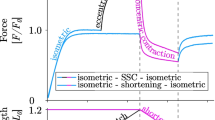Surface EMGs and activity of 73 single motor units (MUs) of the m. triceps brachii caput laterale (TBcl) and 25 units of the m. biceps brachii caput longum (BBcl) were recorded in five adults during unloading within the ramp phase of the isotorque ramp-and-hold movements in the elbow joint (“movement” task) and during maintaining of a certain position (“position control” task). Analysis of the surface EMGs showed that patterns of the MU responses to unloading in different motor tasks are dissimilar. Depending on the responses to unloading, the examined MUs were classified into two groups. Motor units of the first group, including 14 TBcl MUs and 22 BBcl ones, were characterized as task-independent units. Their spiking was completely inhibited in response to unloading in both motor tasks. The second group (44 TBcl and 3 BBcl MUs) should be considered as a group of the task-dependent units. These MUs were active during unloading in the “movement” task but were fully inhibited in the “position control” task. This specificity in the reactions of MUs during movements may be related to their different functions. Presumably, the former group of MUs is mainly involved in the force control, while the latter one is associated with the control of the movement per se.
Similar content being viewed by others
References
B. Kuraszkiewicz, G. Wilanowski, D. Młoźniak, et al., “Review: Selective electrodes for human motoneuron research,” J. Med. Biol. Eng., 34, 415–425 (2014)
A. A. Tax, J. J. Denier van der Gon, C. C. Gielen, and C. M. van den Tempel, “Differences in the activation of m. biceps brachii in the control of slow isotonic movements and isometric contractions,” Exp. Brain Res.,76, 55–63 (1989).
T. Ivanova, S. J. Garland, and K. J. Miller, “Motor unit recruitment and discharge behavior in movements and isometric contractions,” Muscle Nerve,20, 867–874 (1997).
J. Kallio, K. Søgaard, J. Avela, et al., “Motor unit firing behaviour of soleus muscle in isometric and dynamic contractions,” PLoS One8(2), e53425 (2013).
A. N. Tal’nov, T. Tomiak, A. V. Maznychenko, et al., “Firing patterns of human biceps brachii motor units during isotorque ramp-and-hold movements in the elbow joint,” Neurophysiolgy, 46, 212–220 (2014).
A. N. Tal’nov, S. G. Serenko, S. S. Strafun, and A. I. Kostyukov, “Analysis of the electromyographic activity of human elbow joint muscles during slow linear flexion movements in isotorque conditions,” Neuroscience,90, 1123–1136 (1999).
A. Nardone, C. Romano, and M. Schieppati, “Selective recruitment of high-threshold human motor units during voluntary isotonic lengthening of active muscles,” J. Physiol.,409, 451–471 (1989).
A. A. Tax, J. J. Denier van der Gon, C. C. Gielen, and M. Kleyne, “Differences in central control of m. biceps brachii in movement tasks and force tasks,” Exp. Brain Res.,79, 138–142 (1990).
A. A. Tax, J. J. Denier van der Gon, and C. J. Erkelens, “Differences in coordination of elbow flexor muscles in force tasks and in movement tasks,” Exp. Brain Res.,81, 567–572 (1990).
M. Theeuwen, C. C. Gielen, and L. E. Miller, “The relative activation of muscles during isometric contractions and low-velocity movements against a load,” Exp. Brain Res.,101, 493–505 (1994).
B. M. van Bolhuis, W. P. Medendorp, and C. C. Gielen, “Motor unit firing behavior in human arm flexor muscles during sinusoidal isometric contractions and movements,” Exp. Brain Res.,117, 120–130 (1997).
J. Duchateau and R. M. Enoka, “Neural control of shortening and lengthening contractions: influence of task constraints,” J. Physiol.,586, 5853–5864 (2008).
S. Baudry, T. Rudroff, L. A. Pierpoint, and R. M. Enoka, “Load type influences motor unit recruitment in biceps brachii during a sustained contraction,” J. Neurophysiol.,102, 1725–1735 (2009).
T. S. Buchanan and D. G. Lloyd, “Muscle activity is different for humans performing static tasks which require force control and position control,” Neurosci. Lett.,194, 61–64 (1995).
K. S. Maluf, B. K. Barry, Z. A. Riley, and R. M. Enoka, “Reflex responsiveness of a human hand muscle when controlling isometric force and joint position,” Clin. Neurophysiol., 118, 2063–2071 (2007).
C. J. Mottram, E. A. Christou, F. G. Meyer, and R. M. Enoka, “Frequency modulation of motor unit discharge has task-dependent effects on fluctuations in motor output,” J. Neurophysiol.,94, 2878–2887 (2005).
M. H. Schieber, and W. T. Thach, “Trained slow tracking. II. Bidirectional discharge patterns of cerebellar nuclear, motor cortex, and spindle afferent neurons,” J. Neurophysiol.,54, 1228–1270, (1985).
A. Prochazka, M. Hulliger, P. Zangger, and K. Appenteng, “‘Fusimotor set’: new evidence for alphaindependent control of gamma-motoneurones during movement in awake cat,” Brain Res.,339, 136–140, (1985).
P. A. Merton, “Speculations on the servo-control of movement,” in: The Spinal Cord, G. E. W. Wolstenholme (ed), John Wiley and Sons, Chichester (1953).
B. Pasquet, A. Carpentier, and J. Duchateau, “Specific modulation of motor unit discharge for a similar change in fascicle length during shortening and lengthening contractions in humans,” J. Physiol.,577, 753–765 (2006).
T. R. Nicols and J. C. Houk, “Improvement in linearity and regulation of stiffness that results from action of stretch reflex,” J. Neurophysiol.,39, 113–142 (1976).
A. I. Kostyukov, “Muscle dynamics: dependence of muscle length on changes in external load,” Biol. Cybern.,56, 375–387 (1987).
A. I. Kostyukov, “Muscle hysteresis and movement control: a theoretical study,” Neuroscience,83, 303–320 (1998).
A. I. Kostyukov and A. N. Tal’nov, “Effects of torque disturbances on elbow joint movements evoked in unanesthetized cats by microstimulation of the motor cortex,” Exp. Brain Res.,84, 374–382 (1991).
A. G. Feldman, “Once more on the equilibrium point hypothesis (λ-model) for motor control,” J. Mot. Behav.,18, 17–54 (1986).
E. Bizzi, F. Mussa-Ivaldi, and S. Gistzer, “Does the nervous system use equilibrium-point control to guide single and multiple joint movements,” Behav. Brain Sci.,15, 603–613 (1992).
A. I. Kostyukov and A. N. Talnov, “Stretch and unloading reflexes in the cortically evoked movements of unanesthetized cats,” Neurophysiology,24, 330–339 (1992).
J. M. Wilson, C. K. Thompson, L. C. Miller, and C. J. Heckman, “Intrinsic excitability of human motoneurons in biceps brachii versus triceps brachii,” J. Neurophysiol.,113, 3692–3699 (2015).
F. Cotel, M. Antri, J. Y. Barthe, and D. Orsal, “Identified ankle extensor and flexor motoneurons display different firing profiles in the neonatal rat,” J. Neurosci.,29, 2748–2753 (2009).
M. Ishikawa, E. Niemelä, and P. V. Komi, “Interaction between fascicle and tendinous tissues in short-contact stretch-shortening cycle exercise with varying eccentric intensities,” J. Appl. Physiol.,99, 217–223 (2005).
Y. Kawakami and T. Fukunaga, “New insights into in vivo human skeletal muscle function,” Exerc. Sport Sci. Rev.,34, 16–21 (2006).
Author information
Authors and Affiliations
Corresponding author
Rights and permissions
About this article
Cite this article
Maznychenko, A.V., Dovgalets, G.V., Vereshchaka, I.V. et al. Activity of Motor Units in Human Elbow Flexor and Extensor Muscles during Task-Dependent Unloading. Neurophysiology 51, 209–222 (2019). https://doi.org/10.1007/s11062-019-09813-9
Received:
Published:
Issue Date:
DOI: https://doi.org/10.1007/s11062-019-09813-9




